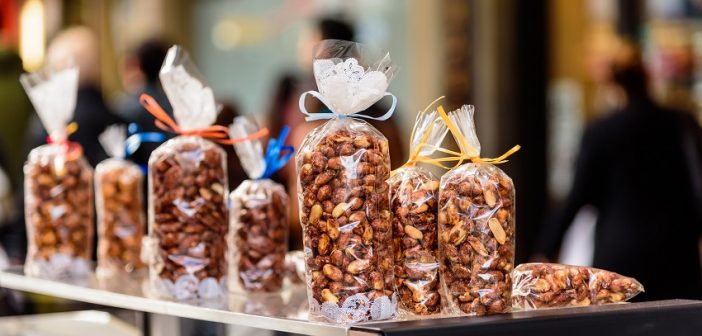What’s your favorite almond snack?
Do you like to eat them raw and by themselves, or do you mix them with trail mix? Maybe you use almond butter instead of peanut butter.
However you eat them, if you like almonds, you’re not alone. People all over the world love almonds, and they’re a surprisingly global food. Their native soil exists in the Middle East, North Africa, and the Indian subcontinent.
People love almonds and consume them in several ways, but not many people know much about them. So, we’ve written this article with several facts about almonds you probably didn’t know. It turns out there’s a lot to learn about this delicious snack!
1. Most US Almonds Come From California
Did you know that all of the almonds grown in the US come from California? It’s not just the US’ almonds that grow there, either. 80% of the almonds consumed in the world come from California. Surprisingly enough, it’s the state’s number 1 agricultural export.
Most of California’s almonds come from family-owned farms, selling the almonds and growing additional crops for themselves. Other places with significant almond supplies include Spain and Australia.
2. The Nuttiest Facts About Almonds
The nuttiest fact about almonds is that they’re technically not a nut! Yes, you read that right. Although the culinary world universally considers almonds to be a nut, scientifically, they’re fruits related to peaches, plums, cherries, and others.
Almonds grow in three parts: the kernel, the hull, and the kernel. The part that we eat is the kernel of the fruit. Think of it like eating the pit of a peach (gross, I know). The cool thing about the other parts of the almond fruit is that farmers don’t waste them. Instead, they feed the hulls to their cattle.
3. Money Doesn’t Grow on Trees, But Almonds Do
Here’s one of the more fun almond facts. Did you ever give much thought to where almonds come from? If not, you’ll find out here. Almonds grow on trees, similar to their other fruit relatives. Almond trees have a lifespan of 20-25 years, and they produce beautiful flowers in the spring.
In southern Spain, almond flowers bring the same kind of tourism that cherry blossoms attract to Japan. Their flowers typically come in shades of white and pink, eventually opening up to reveal their almond fruits.
4. Almonds Need Bees to Survive
People may not be that fond of bees or any other stinging insects for that matter, but almonds rely on them. There are some 30 different types of almonds, but none of them can self-pollenate.
Instead, they rely on the pollen from other types of almonds to pollenate them. This phenomenon is called “self-incompatibility.” So, where do the bees come in?
Bees are the ones who carry the pollen from one type of almond to another. They’re so essential to the process that California farmers often rent honey bees to help them pollinate their almond plants. They usually rent the bees for periods of about six weeks.
5. Pasteurized Almonds
Even when you buy raw almonds in the US, they’re not really raw. All US almonds go through heat processing during their pasteurization process. US law requires this process, or else the almonds could become spoiled.
However, if you’re interested in experiencing purely raw almonds, you can do it. All you have to do is find almonds grown outside the US. If you’re disappointed about your almonds being “processed,” don’t be.
Even though almonds go through a minimal pasteurization process, they are still natural. No additives or other would-be contaminants enter the almond before they go to stores.
6. Almonds Have a Slow Production
Almonds go through quite the process to reach your local supermarket. It turns out you can’t just go picking almonds off trees and expect to retain the benefits of almonds.
Instead, farmers use machine shakers to cause almonds to fall from their trees. They then leave them on their orchard ground for a week or so, allowing them to dry completely. Then, a machine called a sweeper comes through and sweeps the almonds up for their packaging.
7. Eating Healthy With Almonds
Almonds are a delectable snack both for their satisfying crunch and their health benefits. Almonds possess many heart-healthy fats that make them beneficial for your body.
Almonds also have a high protein content (for a nut, anyway), along with fiber, magnesium, and vitamin E. Almonds can also help reduce blood pressure and lower cholesterol. If you want to check out some delicious almonds, this company has an excellent selection.
8. Have You Ever Had Green Almonds?
Most people probably don’t know this, but green almonds exist. These almonds resemble grapes in their shape, and in many parts of the world, they’re considered a delicacy. Some high-class restaurants provide these almonds as a snack.
9. What Are the Three Main Types of Almonds?
If somebody ever asks you this question in a round of trivia, now you’ll be prepared. There are over 30 types of almonds, but there are three that are most commonly end up in shops.
These three are the Nonpareil, Carmel, and Butte almonds. In America, we’re most familiar with Nonpareil almonds.
10. Almonds Have Few Calories
Here’s a fact everyone can appreciate! Part of why almonds are so popular in fitness circles is that they have a low-calorie count. Despite this, almonds also lessen hunger at a faster rate than other snacks.
Due to its many healthy properties, a handful of almonds and some fruit make a perfect afternoon snack.
11. 40% of Almonds Go to Chocolate
Sure, almonds are tasty and healthy. However, if you want something rich and sweet, several chocolates utilize almonds in their ingredients.
Not only do people use almonds for chocolate, but they also appear in several pastries.
Pick Up Some Almonds Today
After all these facts about almonds, you must be hungry. So, if want a quick snack, almonds are always a good choice.
We hope you enjoyed this article! If so, check out more of our content today.




